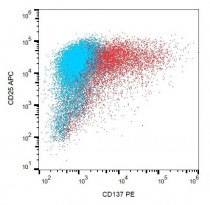ARG42273
anti-CD137 antibody [4B4-1] (PE)
anti-CD137 antibody [4B4-1] (PE) for Flow cytometry and Human,Primates
Overview
| Product Description | PE-conjugated Mouse Monoclonal antibody [4B4-1] recognizes CD137 |
|---|---|
| Tested Reactivity | Hu, NHuPrm |
| Tested Application | FACS |
| Specificity | The mouse monoclonal antibody 4B4-1 recognizes an extracellular conformational epitope on CD137, an approximately 40 kDa type I transmembrane protein of the TNFR family expressed mainly on activated T cells. |
| Host | Mouse |
| Clonality | Monoclonal |
| Clone | 4B4-1 |
| Isotype | IgG1, kappa |
| Target Name | CD137 |
| Antigen Species | Human |
| Immunogen | Recombinant Human CD137 ectodomain. |
| Conjugation | PE |
| Alternate Names | ILA; CD137; T-cell antigen 4-1BB homolog; CDw137; T-cell antigen ILA; 4-1BB; CD antigen CD137; Tumor necrosis factor receptor superfamily member 9; 4-1BB ligand receptor |
Application Instructions
| Application Suggestion |
|
||||
|---|---|---|---|---|---|
| Application Note | * The dilutions indicate recommended starting dilutions and the optimal dilutions or concentrations should be determined by the scientist. |
Properties
| Form | Liquid |
|---|---|
| Purification | Purified |
| Buffer | PBS and 15 mM Sodium azide. |
| Preservative | 15 mM Sodium azide |
| Storage Instruction | Aliquot and store in the dark at 2-8°C. Keep protected from prolonged exposure to light. Avoid repeated freeze/thaw cycles. Suggest spin the vial prior to opening. The antibody solution should be gently mixed before use. |
| Note | For laboratory research only, not for drug, diagnostic or other use. |
Bioinformation
| Database Links |
Swiss-port # Q07011 Human Tumor necrosis factor receptor superfamily member 9 |
|---|---|
| Gene Symbol | TNFRSF9 |
| Gene Full Name | tumor necrosis factor receptor superfamily, member 9 |
| Background | The protein encoded by this gene is a member of the TNF-receptor superfamily. This receptor contributes to the clonal expansion, survival, and development of T cells. It can also induce proliferation in peripheral monocytes, enhance T cell apoptosis induced by TCR/CD3 triggered activation, and regulate CD28 co-stimulation to promote Th1 cell responses. The expression of this receptor is induced by lymphocyte activation. TRAF adaptor proteins have been shown to bind to this receptor and transduce the signals leading to activation of NF-kappaB. [provided by RefSeq, Jul 2008] |
| Function | Receptor for TNFSF9/4-1BBL. Possibly active during T cell activation. [UniProt] |
| Cellular Localization | Membrane; Single-pass type I membrane protein. [UniProt] |
| Calculated MW | 28 kDa |
Images (1) Click the Picture to Zoom In






